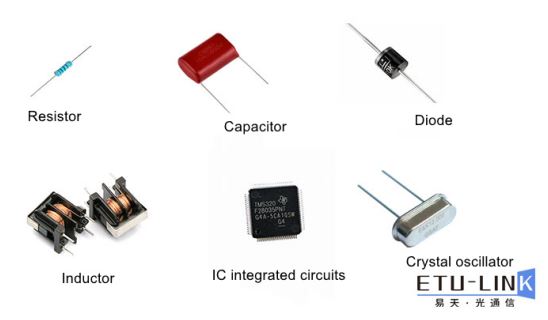
Analysis of PCBA board electronic components
In this blog, ETU-LINK will introduce the electronic components of the PCBA board in the optical module. The circuit board without soldering electronic components is called PCB. PCB is divided into single-sided circuit board, double-sided circuit board and multi-layer boards, in which single-sided circuit boards have only one layer and only one side has circuits, double-sided circuit boards have two layers and circuits on both sides, and multi-layer boards have three layers and above, and each layer has circuits.
After talking about the circuit board, let's learn about electronic components. All components can be divided into Surface Mounted Technology components (SMT) and Plating Through Hole components (PTH). SMT is a component designed to stick to the board. ETU-LINK will list the following electronic components for analysis.

1. Resistor
Resistors are divided into PTH resistors and SMT resistors. The function of the resistor is to limit the flow of current, reduce the voltage, distribute the voltage, stabilize and adjust the current. The resistance is represented by "R" and has no polarity. The unit of resistance is ohm Ω.
2. Capacitor
Two conductors that are close to each other with a non-conductive insulating medium sandwiched between them form a capacitor. A capacitor stores charge when a voltage is applied between its two plates. The capacitance of a capacitor is numerically equal to the ratio of the amount of charge on one conducting plate to the voltage between the two plates. The basic unit of capacitance of a capacitor is the farad (F). Capacitive elements are usually represented by the letter C in circuit diagrams.
3. Inductor
An inductor is a component that can convert electrical energy into magnetic energy and store it. The structure of an inductor is similar to that of a transformer, but with only one winding. An inductor has a certain inductance, it only resists changes in current flow. If the inductor has no current flowing through it, it will try to block the flow of current through it when the circuit is on; if the inductor has current flowing through it, it will try to maintain the current flow when the circuit is off. Inductor, also known as choke, reactor, dynamic reactor.
4. Diode
A diode is an electronic device made of semiconductor materials (silicon, selenium, germanium, etc.). It has unidirectional conductivity, when a forward voltage is applied to the anode and cathode of the diode, the diode conducts. When a reverse voltage is applied to the anode and cathode, the diode is turned off. Therefore, the on and off of the diode is equivalent to the on and off of the switch.
Diode is one of the earliest semiconductor devices, and its application is very wide. Especially in various electronic circuits, diodes and resistors, capacitors, inductors and other components are used for reasonable connection to form circuits with different functions, which can realize rectification of alternating current, detection of modulated signals, amplitude limiting and clamping, and power supply. Voltage regulation and other functions. Diode traces can be found in common radio circuits as well as in other household appliances or industrial control circuits.
5. IC integrated circuits
An IC integrated circuit is a miniature electronic device or component. Using a certain process, components and wirings such as transistors, diodes, resistors, capacitors and inductors required in a circuit are interconnected, fabricated on a small or several small semiconductor wafers or dielectric substrates, and then encapsulated in a tube, it becomes a miniature structure with the required circuit functions; all the components are structurally integrated, which makes the electronic components take a big step towards miniaturization, low power consumption and high reliability.
6. Crystal oscillator
The crystal oscillator has a piezoelectric effect, the crystal will be deformed after a voltage is applied to the two poles of the wafer. Conversely, if the external force deforms the wafer, the metal sheet on the two poles will generate a voltage. If an appropriate alternating voltage is applied to the wafer, the wafer will resonate (the resonant frequency is related to the inclination of the quartz bevel, etc., and the frequency is constant). The crystal oscillator uses a crystal that can convert electrical energy and mechanical energy into each other, and works in a resonance state to provide stable and precise single-frequency oscillation. Under normal working conditions, the absolute accuracy of ordinary crystal frequency can reach 50 parts per million. Using this feature, the crystal oscillator can provide a relatively stable pulse, which is widely used in the clock circuit of the microchip. The wafers are mostly quartz semiconductor materials, and the shell is packaged with metal.
Categories
New Blog
Tags
© Copyright: 2025 ETU-Link Technology CO ., LTD All Rights Reserved.

IPv6 network supported
Friendly Links:
易天官网